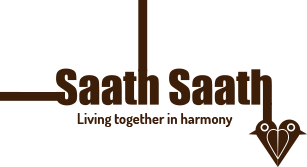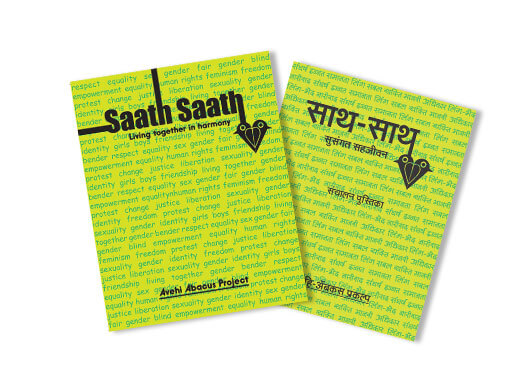
Responding to the increasing awareness about gender parity and ironically, the growing violence against the female sex, the AVEHI ABACUS PROJECT has developed a module on Gender titled Saath Saath - Living together in harmony. It has been developed to generate respect for individuals irrespective of their biological sex. It aims to create an awareness that requires not just intellectual effort but sensitivity and open-mindedness.
Read moreAs the name Saath Saath suggests, the main intention of this effort is to work together to address the problems related to gender and create a future where girls and boys, women and men will have equal respect and an equal chance for a better life.
The first step in this journey therefore is to recognize that today women are treated unfairly and are considered unequal to men. Not just in our own society but also all over the world, discrimination on the basis of gender continues to take place either openly or covertly in every social institution – beginning in the home and family, and affecting the public sphere as well. Patriarchy continues to rule the roost. And this adversely affects boys and men as well.
But it is equally true that society’s understanding of women’s roles is slowly – but surely – changing. The right to education, the right to vote and participate in the running of a country, the right to work and the right to equal wages for equal work, the right to seek justice – these are rights that women haven’t had as long as men. Each of these signifies a fight, a revolution. These are rights enshrined in our Constitution, guaranteed by law to every girl and woman irrespective of caste, race, religion or region.
Today children are exposed to a plethora of inputs from their peers and the media which reinforce gender stereotypes and add to the confusion. Teachers and parents too are often unclear about what they can do to guide their wards. The need for verified information and discussion is hence urgent; this is important for girls as well as boys and calls for active engagement on part of the teacher and learner. Yet there is very little material available for use in schools that talks about the relevant issues in an interesting and safe manner. This module aims to fill that vacuum - to help children make sense of the world they encounter as they grow towards maturity.
We are trying to initiate a process of change in how children think and how they apply their insights to the choices they make in real life. For this to happen, children need a certain body of experience that they can draw upon and revisit; children in the age group of 12 to 16 have developed abilities required for such analysis, reflection and decision-making. Thus we have created this age-appropriate, comprehensive resource rooted in the principles of critical pedagogy.
The Saath Saath curriculum

The themes covered in Year One focus on the fundamentals of education. The sessions look at the some of the players in the field of education, their roles and the impact that they have, as well as the ways in which we learn. They go on to explore the history of education in India, and finally discuss Curriculum, Methodology, and Assessment in greater detail.
Read MoreThe first session looks at the difference between sex (as a biological aspect of our bodies) and gender (as a social construct based on biological differences).
The second session mainly deals with adolescence. It looks at how our bodies change as we grow and how, because girls’ and boys’ bodies develop differently, they are treated in significantly different ways. They are expected to fit into specific gender roles and conform to certain modes of behavior. The session asks if such treatment is fair.
Session three focuses on the notions individuals have about Gender and the fact that they are so deeply ingrained that we seldom question them. Such notions are passed down from generation to generation and are believed to be part of our culture. Even exposure to modern ideas or the different practices that prevail in less unequal societies do not affect these notions. It is therefore important to decode them, to see how this pressure to conform is unfair to both men and women and has adversely affected the development of society.
Session four looks at how the process of gendering starts from childhood – it begins by critically examining fairy tales and other stories that we have grown up listening to – do these stories indulge in gender stereotypes and do they teach children about the gender roles that they are expected to fill?
Session five talks about family, which is the cradle of socialization for most individuals. It looks at how we begin learning gender roles at home – the importance given to the work that women and men are expected to do and their relative status within the family. Since these are attitudes that we learn at a very young age and from people we love, it is hard to acknowledge that they are discriminatory; hence such attitudes persist over generations. In fact, ‘family is the school of patriarchy’.
Sixth session looks at the pressures that young people face when growing up and how peer groups influence our notions of gender and gender roles. Interactions on the Internet, pornography, body image, and sexual curiosity are also themes that are looked at. This session uses stories and incidents to talk about the various situations that young people might find themselves in, the possible ways to deal with these situations, and how we can be more aware of the gender stereotypes that the peer group may perpetuate.
Session seven looks at the influence of mass media on our lives today is undeniable hence it is imperative to scrutinize the impression that it can make on young minds. The representation of gender and gender roles, ideals of what constitute masculinity and femininity, Advertising and its commodification of women, are some of the aspects are looked at in the presentations made in session seven.
Session eight talks about the work that women do. Often given less importance and recognition, unpaid or under-paid, with fewer educational and vocational opportunities, women constitute half the world’s population but receive only one-tenth of the total income. Students are nudged to reflect on their own notions and, through a worksheet, talk to their sisters, mothers, and grandmothers to see how much the role of women has changed over the generations and what this change means.
Ninth session focuses on what sexual violence means, how it can impact children and how they can deal with it. These days several terms are being used interchangeably such as sexual violence, sexual harassment, sexual abuse, rape, etc. and this can confuse and scare young people. This session talks about instances of unacceptable behaviour/harassment that students may experience. They may also be committing inappropriate acts that they are not aware of themselves - like bullying or teasing. Care has been taken to make sure that students understand that both boys and girls can be victims of sexual harassment.
Going forward from the previous session, session ten deals with more extreme forms of sexual violence. Although this is a sensitive topic, it is imperative for students to understand that rape (and other forms of sexual violence) is an act of expressing power and subjugation as women are often seen as property. It is important to stress on the fact that rape is never the fault of the victim. Session ten also looks at the laws relating to rape in India as well as the social reforms that have helped to change the position of women and mitigate the violence against them.
Session eleven focuses on what it means to be an empowered person. It is only when we learn to accept differences and believe in the rights of all, that we can have a fair and just society. Any form of violence upsets the fabric of society but we are also capable of curbing violence and ending discrimination. This session looks at how empowerment contributes positively to society and what the qualities of an empowered person are.
The last session of this Kit recaps and ties up what has been learnt in the previous sessions. While positive change has occurred and there is far more gender fairness and equality than there was two generations ago, there is still a way to go. Further change is possible only if individuals, and particularly young people, question and address continued discriminations. Equality and fairness cannot be taken for granted, and constant efforts have to be made so that we can obtain a gender blind and truly empowered society.
Extracts: Session 8: Women’s work: Invisible but vital
PROCURING Saath Saath KITS
The Saath Saath kit is available for use by individuals / organizations working with children between the ages of 12 to 16 years. Please contact us for further details.
AVEHI ABACUS PROJECT
Second Floor, K.K. Marg Municipal School,
Saat Rasta, Mahalaxmi,
Mumbai 400 011.
Tel: +91-22-23075231
+91-22-23052790
e-Mail: avehiabacus@gmail.com
KIT 1: MYSELF, MY BODY, OUR NEEDS
Knowing about MYSELF means understanding that I am unique and yet I share some thing with every other human being. It means understanding the potential and limitations of MY BODY, and realizing that regardless of our differences all human beings have the same NEEDS. The kit begins by getting each child to understand ‘Myself’, starting with the physical and emotional self, and explores the various influences on a child - family, school, friends, the media, and the place in which he/she lives.
Throughout these sessions, some fundamental values are underlined: namely, that every human being is a unique individual who must be respected and valued, no matter how different from us; that it is a variety of individuals living together that make up a society; that this diversity makes our society richer and is therefore worth protecting and preserving; that in spite of these differences, there are several similarities that unite all human beings.
The ‘Body’ is the most obvious part of the self. Which is why, after exploring the self, we move on to understanding different aspects of the human body - the different systems of the body, the role of the mind and emotions, the changes that take place as part of the process of growing up and the importance of taking care of the body in order to keep it in good health.
Though ‘Our needs’ is a short section, it is important because it helps children understand a simple but very important idea – that all human beings have the same basic needs, though people have different ways of fulfilling them. This variety in ways of living enriches human life. Besides since all human beings share these needs, everyone should have the right to fulfill them. Another important value emphasized is that the work of many different people helps fulfill our needs; hence human labour must be respected.
